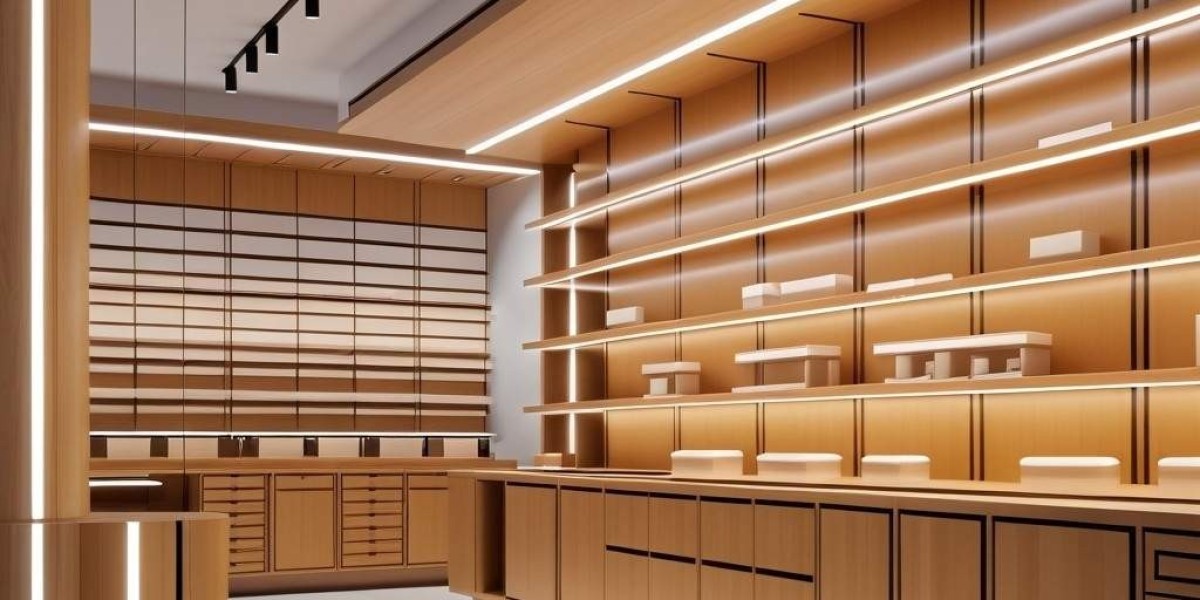Summary: This post traces commercial millwork moving from fabrication (the factory) to installed realities in a store or building. You’ll see critical steps, coordination needs, and how Teamwork ensures quality at each phase, without overpromising, just realistic, service-based insight. |
When you enter a store, hotel, or public space, many of the woodwork, cabinets, partitions, and built-ins you observe must have gone through a lengthy and detailed process before being placed. That process, from the facility where millwork is made to the shop where it’s all up, is complicated and calls for accuracy, organization, and flow.
In this post, we map out that journey, step by step, and show how a professional installation partner like Teamwork supports each stage to deliver a successful commercial millwork installation.
Design & Fabrication Stage
Design handoff and specifications
The process begins with submitting detailed drawings, material specifications, tolerances, and sequences by the architects, designers, or millwork fabricators. Shop sketches that are clear and dimensionally accurate are essential. For example, door clearances, panel joins, reveal gaps, and anchoring locations must be defined upfront.
Teamwork does not fabricate these pieces (fabricators handle that). Still, we work closely with fabricators and design teams to review drawings, flag potential installation issues (like access constraints, wall conditions, or weight/load limits), and make adjustments early.
Quality review in the shop
Before units leave the factory, it’s beneficial to inspect key aspects: flatness, finish quality, edge conditions, predrilled holes, hardware preps, and labeling. Some installers or project managers may conduct a shop walk or request sample mockups. Catching issues early here saves time and potential rework later on-site.
Logistics, Staging & Delivery
Packaging, labeling & crating
Millwork components must be carefully created, protected, and labeled so installers can identify each piece upon arrival. Damage in transit or mislabeling can cause delays, misplacement, or re-fabrication.
Teamwork works with logistics teams to ensure parts are shipped in safe, protective packaging and that each crate is clearly marked with location, orientation, and handling instructions.
Site staging and access planning
A well-coordinated installation requires a staging plan: where crates will land, how far installers must carry or mechanize them, and how to route them to final locations (through doors, elevators, corridors). At this stage, we often perform site walks or coordinate with general contractors (GCs) to confirm access, floor protection, and temporary storage zones.
Synchronization of delivery with installation sequencing is crucial so installers have the right parts at the right time without causing congestion.
On-Site Installation Execution
Precision placement and leveling
Installers must properly use tools, jigs, shims, and laser levels to ensure that the parts are flush-fitted, vertically/horizontally aligned, and that finish tolerances are met. Every element, be it for the cabinetry, built-ins, wood paneling, or decorative millwork, must be plumb, square, and level.
The teamwork crew is trained to work with precision and high tolerances, and they check the joints and reveal consistency and squareness as the work progresses.
Anchoring & connection
The woodwork fixtures must be strongly bolted to the wall, floor, ceiling structures, or supports. This requires close coordination with the structure, checking the substrate conditions, and incorporating the fasteners’ or brackets’ locations to appear visually appealing. The local irregularities, such as shimming or grout, might have to be made, for which the crews responsible will make the necessary exclusions from the location.
Field modifications & adjustments
When the best shop drawings are used at the construction site, there could still be some differences when wall conditions are not plumb, floor elevations may move, or utilities may be interfering. In such cases, installers have to do such things as trimming, scribing, or tweaking parts to fit perfectly in the field. Professional installers usually have to bring their tools, jigs, and materials for doing small things, and then they have to do the work that will be clean and unnoticeable.
Quality Assurance & Final Walkthrough
In-progress checks
Throughout installation, quality checkpoints help catch issues early. For example, periodically measure alignment, inspect finishes, verify that doors/drawers operate, check reveal gaps, and confirm installation tolerances.
Teamwork emphasizes a controlled execution where parts are not simply placed, but continuously verified during installation.
Punch list & client walkthrough
After the bulk of the work is complete, a formal walkthrough is scheduled with the project manager, GC, or client representatives. All elements are inspected; alignment, finish conditions, operation, caulking, touch-ups, and function. Any punch items are documented, prioritized, and resolved.
Teamwork treats the punch list as part of the job, not an afterthought.
Post-Install Support & Maintenance
Adjustments & reconfigurations
Over time, spaces evolve. Whether new tenants, changing layouts, or wear, some millwork may need adjustment, reconfiguration, or retrofits. Teamwork offers post-install support to address these updates efficiently.
Warranty and care guidelines
Though the installer’s role ends, guidance on cleaning, finish care, and periodic maintenance can prolong the life of millwork. Teams and building owners benefit from having clear care instructions for wood finishes, hardware, and joinery.
How Teamwork Bridges the Journey
What ensures the journey from factory to storefront is successful is careful coordination, communication, and experience and that’s where Teamwork steps in. Some ways we add value include:
- Design review & coordination: We flag potential site constraints or installation issues before fabrication begins.
- Site and logistics planning: We coordinate deliveries, staging, and installation sequencing to prevent delays and conflicts.
- Skilled installation crews: Our teams bring training, tools, and experience to execute calibration, anchoring, and finishing with care.
- Quality control approach: Continuous measurement, checkpoints, and client walkthroughs help us deliver to spec.
- Post-install flexibility: We don’t walk away; we offer adjustment, reconfiguration, and maintenance services.
Because Teamwork operates nationally, scaling from single-site installs to multi-location rollouts is part of our DNA.
Conclusion
The transformation from a millwork shop floor to an installed, functioning storefront is far from trivial. It demands design accuracy, precise fabrication, smart staging, skilled installation, and ongoing support. By understanding each stage and working with a partner like Teamwork that respects those transitions; you mitigate risk and achieve durable, high-quality commercial millwork installation results.
If you’re planning a project where millwork is vital, consider involving your installation partner early. That reduces surprises and helps ensure the vision becomes a built reality.
FAQs
Q1: Do you fabricate the millwork or just install it?
The role of Teamwork is installation (and related field services). We coordinate with fabricators, designers, and general contractors, but do not manufacture custom millwork in-house.
Q2: How far in advance should installation planning begin?
As early as possible, ideally concurrent with fabrication and even during design. Early coordination allows us to spot access constraints, staging limitations, and site conditions that might affect installation.
Q3: What if field conditions differ from shop drawings?
That’s expected in many projects. Professional crews carry tools and materials to make adjustments, scribe, trim, or shim components so they fit precisely and look seamless.
Q4: Can Teamwork handle multi-site rollouts and consistent millwork installation across locations?
Yes. Teamwork supports national or regional rollouts with mobile crews and in-house coordination to maintain consistent install standards across multiple sites.
Q5: What commitments does Teamwork make regarding quality and follow-up?
Teamwork integrates a quality control process; ongoing checks, walkthroughs, and punch-item resolution. We also offer post-install support, adjustments, and reconfiguration work over time.



